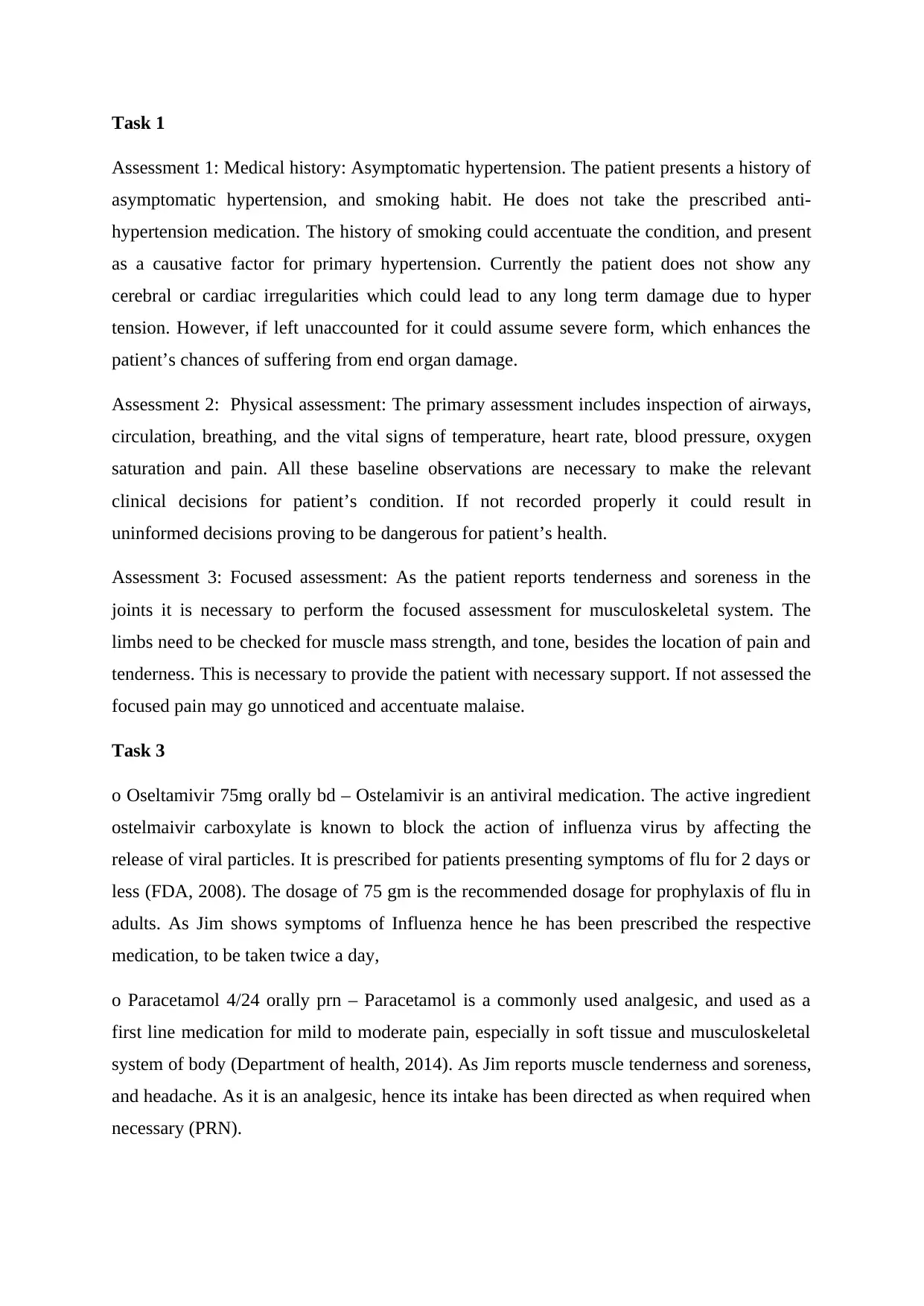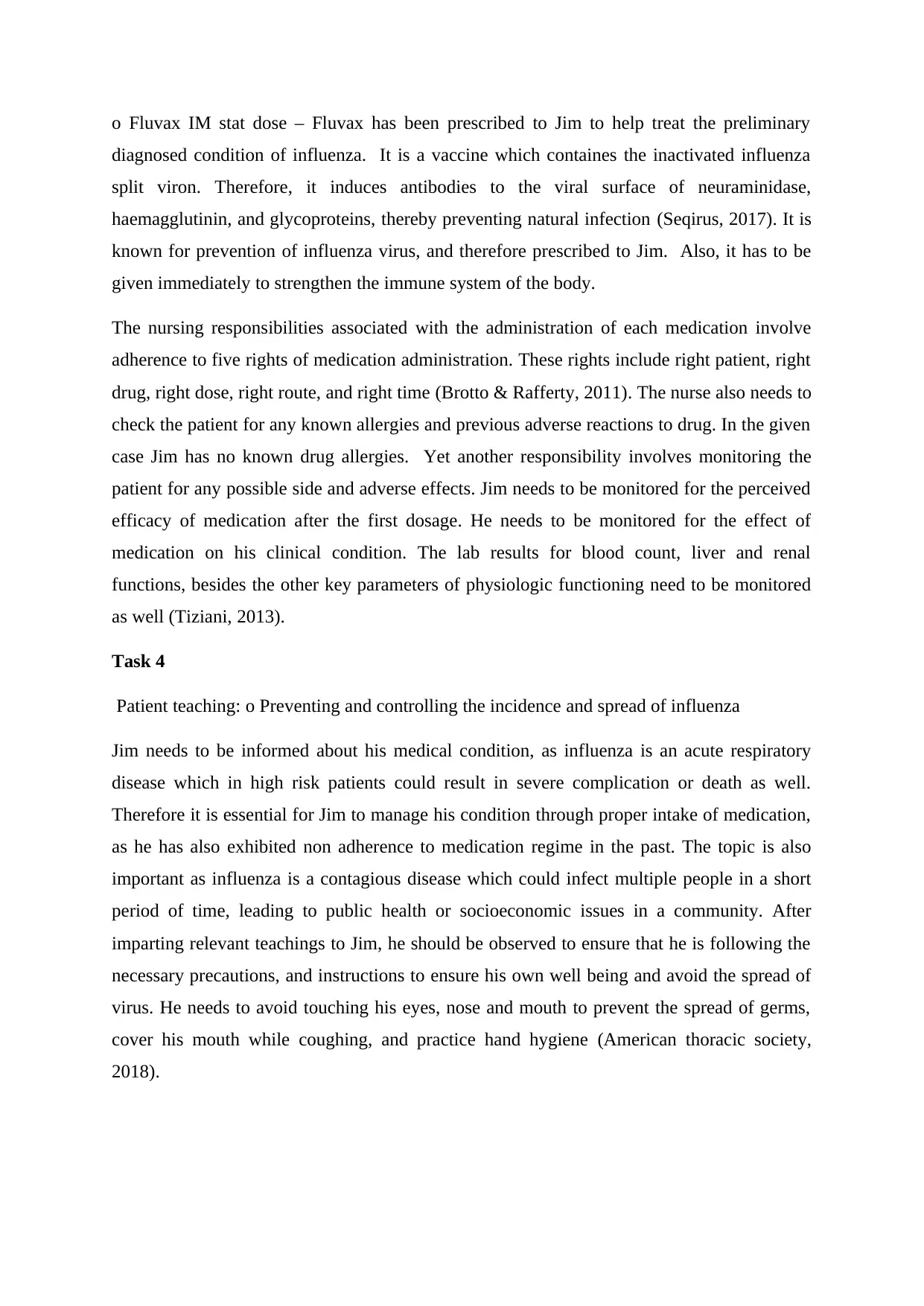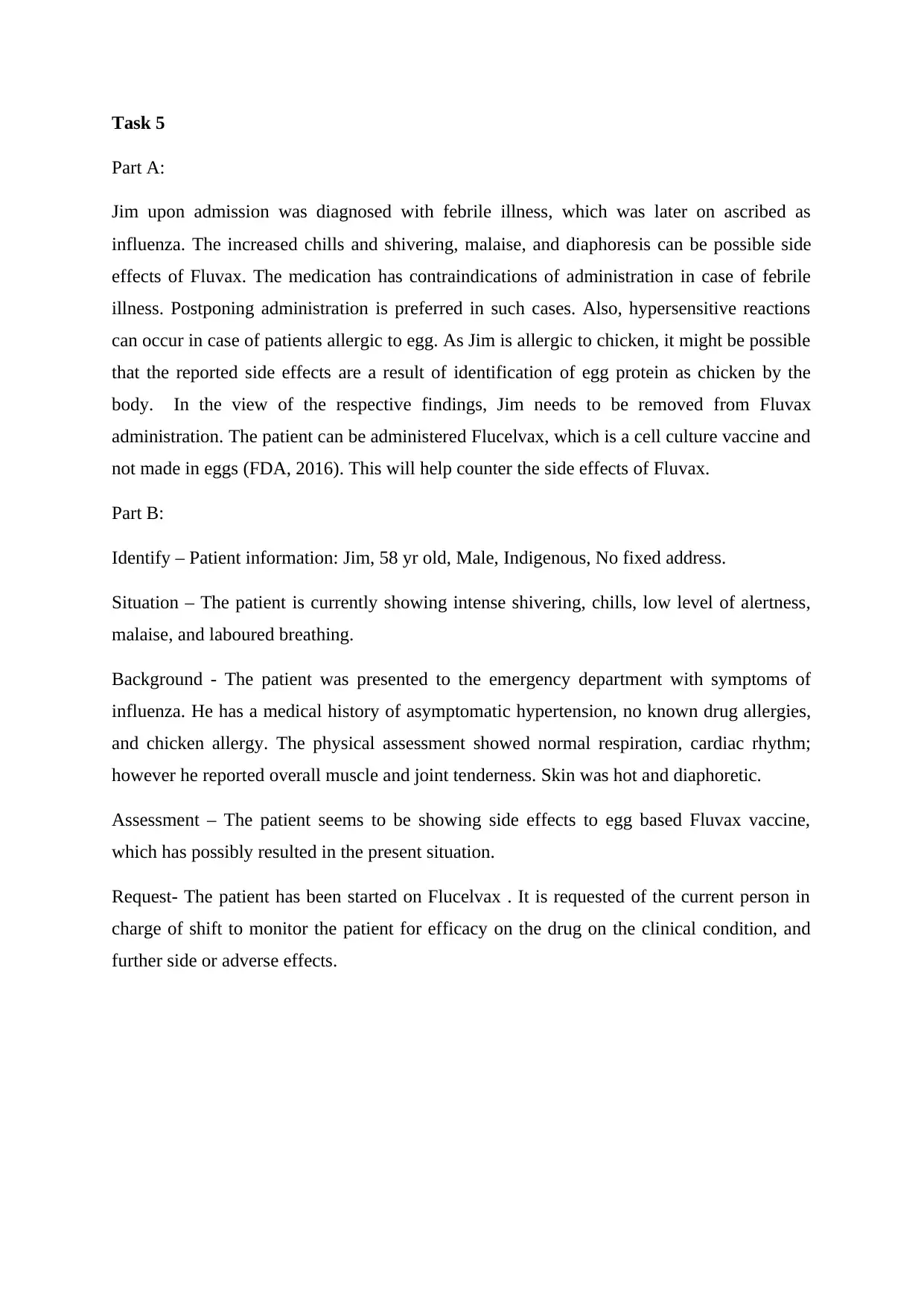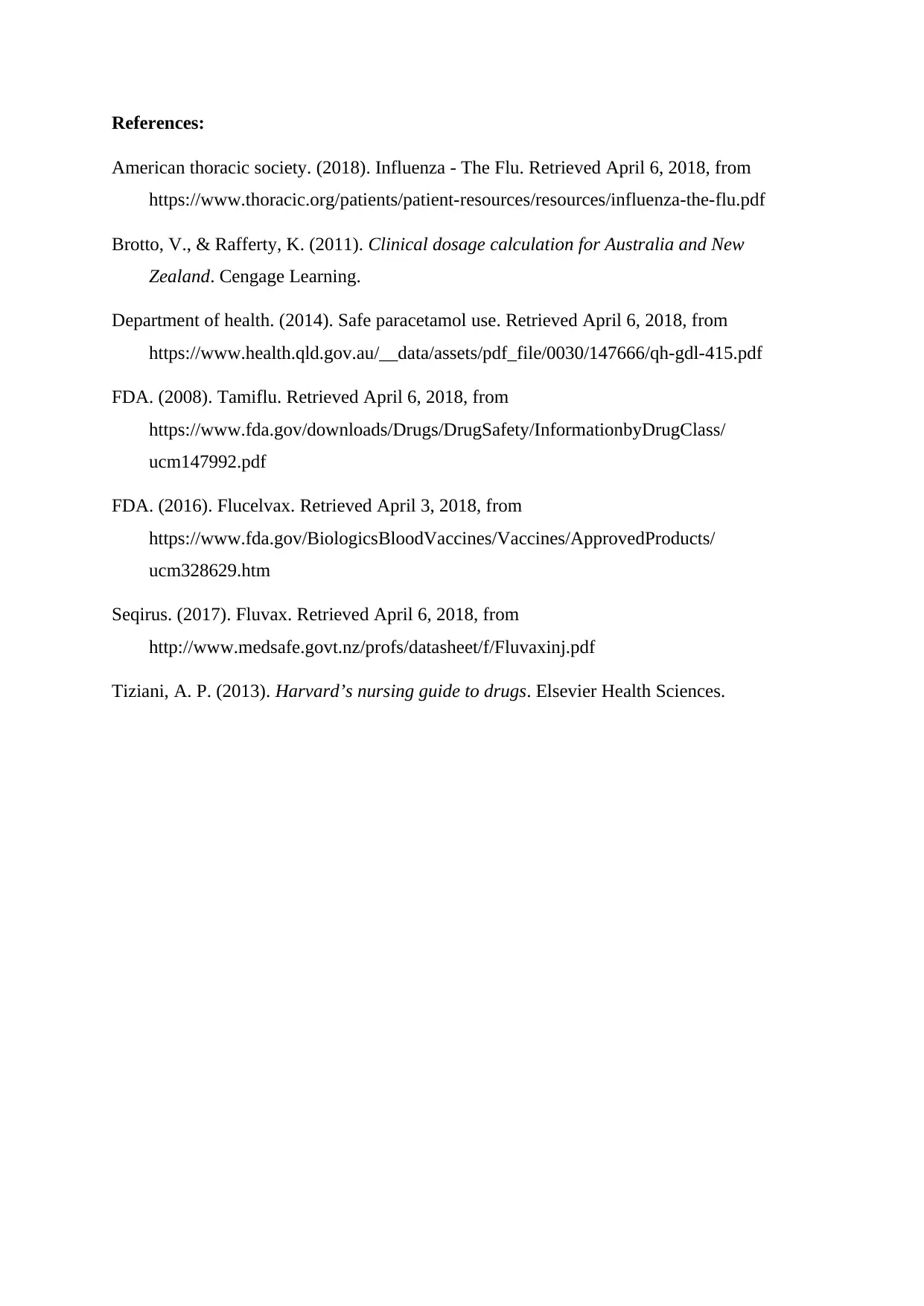Nursing Assessment and Medication Management for Influenza Patient
VerifiedAdded on 2021/04/24
|4
|1317
|79
Practical Assignment
AI Summary
This assignment presents a nursing case study of a 58-year-old male patient, Jim, diagnosed with influenza. The assessment includes medical history of asymptomatic hypertension, physical assessment of vital signs, and a focused assessment of the musculoskeletal system due to reported joint tenderness. The patient is prescribed Oseltamivir, Paracetamol, and Fluvax. The nursing responsibilities include adhering to the five rights of medication administration, monitoring for side effects, and monitoring lab results. The assignment also covers patient teaching on preventing the spread of influenza and addresses the patient's adverse reaction to Fluvax, recommending Flucelvax as an alternative. The case study includes a detailed SBAR (Situation, Background, Assessment, Recommendation) report and references supporting the clinical decisions.

Task 1
Assessment 1: Medical history: Asymptomatic hypertension. The patient presents a history of
asymptomatic hypertension, and smoking habit. He does not take the prescribed anti-
hypertension medication. The history of smoking could accentuate the condition, and present
as a causative factor for primary hypertension. Currently the patient does not show any
cerebral or cardiac irregularities which could lead to any long term damage due to hyper
tension. However, if left unaccounted for it could assume severe form, which enhances the
patient’s chances of suffering from end organ damage.
Assessment 2: Physical assessment: The primary assessment includes inspection of airways,
circulation, breathing, and the vital signs of temperature, heart rate, blood pressure, oxygen
saturation and pain. All these baseline observations are necessary to make the relevant
clinical decisions for patient’s condition. If not recorded properly it could result in
uninformed decisions proving to be dangerous for patient’s health.
Assessment 3: Focused assessment: As the patient reports tenderness and soreness in the
joints it is necessary to perform the focused assessment for musculoskeletal system. The
limbs need to be checked for muscle mass strength, and tone, besides the location of pain and
tenderness. This is necessary to provide the patient with necessary support. If not assessed the
focused pain may go unnoticed and accentuate malaise.
Task 3
o Oseltamivir 75mg orally bd – Ostelamivir is an antiviral medication. The active ingredient
ostelmaivir carboxylate is known to block the action of influenza virus by affecting the
release of viral particles. It is prescribed for patients presenting symptoms of flu for 2 days or
less (FDA, 2008). The dosage of 75 gm is the recommended dosage for prophylaxis of flu in
adults. As Jim shows symptoms of Influenza hence he has been prescribed the respective
medication, to be taken twice a day,
o Paracetamol 4/24 orally prn – Paracetamol is a commonly used analgesic, and used as a
first line medication for mild to moderate pain, especially in soft tissue and musculoskeletal
system of body (Department of health, 2014). As Jim reports muscle tenderness and soreness,
and headache. As it is an analgesic, hence its intake has been directed as when required when
necessary (PRN).
Assessment 1: Medical history: Asymptomatic hypertension. The patient presents a history of
asymptomatic hypertension, and smoking habit. He does not take the prescribed anti-
hypertension medication. The history of smoking could accentuate the condition, and present
as a causative factor for primary hypertension. Currently the patient does not show any
cerebral or cardiac irregularities which could lead to any long term damage due to hyper
tension. However, if left unaccounted for it could assume severe form, which enhances the
patient’s chances of suffering from end organ damage.
Assessment 2: Physical assessment: The primary assessment includes inspection of airways,
circulation, breathing, and the vital signs of temperature, heart rate, blood pressure, oxygen
saturation and pain. All these baseline observations are necessary to make the relevant
clinical decisions for patient’s condition. If not recorded properly it could result in
uninformed decisions proving to be dangerous for patient’s health.
Assessment 3: Focused assessment: As the patient reports tenderness and soreness in the
joints it is necessary to perform the focused assessment for musculoskeletal system. The
limbs need to be checked for muscle mass strength, and tone, besides the location of pain and
tenderness. This is necessary to provide the patient with necessary support. If not assessed the
focused pain may go unnoticed and accentuate malaise.
Task 3
o Oseltamivir 75mg orally bd – Ostelamivir is an antiviral medication. The active ingredient
ostelmaivir carboxylate is known to block the action of influenza virus by affecting the
release of viral particles. It is prescribed for patients presenting symptoms of flu for 2 days or
less (FDA, 2008). The dosage of 75 gm is the recommended dosage for prophylaxis of flu in
adults. As Jim shows symptoms of Influenza hence he has been prescribed the respective
medication, to be taken twice a day,
o Paracetamol 4/24 orally prn – Paracetamol is a commonly used analgesic, and used as a
first line medication for mild to moderate pain, especially in soft tissue and musculoskeletal
system of body (Department of health, 2014). As Jim reports muscle tenderness and soreness,
and headache. As it is an analgesic, hence its intake has been directed as when required when
necessary (PRN).
Paraphrase This Document
Need a fresh take? Get an instant paraphrase of this document with our AI Paraphraser

o Fluvax IM stat dose – Fluvax has been prescribed to Jim to help treat the preliminary
diagnosed condition of influenza. It is a vaccine which containes the inactivated influenza
split viron. Therefore, it induces antibodies to the viral surface of neuraminidase,
haemagglutinin, and glycoproteins, thereby preventing natural infection (Seqirus, 2017). It is
known for prevention of influenza virus, and therefore prescribed to Jim. Also, it has to be
given immediately to strengthen the immune system of the body.
The nursing responsibilities associated with the administration of each medication involve
adherence to five rights of medication administration. These rights include right patient, right
drug, right dose, right route, and right time (Brotto & Rafferty, 2011). The nurse also needs to
check the patient for any known allergies and previous adverse reactions to drug. In the given
case Jim has no known drug allergies. Yet another responsibility involves monitoring the
patient for any possible side and adverse effects. Jim needs to be monitored for the perceived
efficacy of medication after the first dosage. He needs to be monitored for the effect of
medication on his clinical condition. The lab results for blood count, liver and renal
functions, besides the other key parameters of physiologic functioning need to be monitored
as well (Tiziani, 2013).
Task 4
Patient teaching: o Preventing and controlling the incidence and spread of influenza
Jim needs to be informed about his medical condition, as influenza is an acute respiratory
disease which in high risk patients could result in severe complication or death as well.
Therefore it is essential for Jim to manage his condition through proper intake of medication,
as he has also exhibited non adherence to medication regime in the past. The topic is also
important as influenza is a contagious disease which could infect multiple people in a short
period of time, leading to public health or socioeconomic issues in a community. After
imparting relevant teachings to Jim, he should be observed to ensure that he is following the
necessary precautions, and instructions to ensure his own well being and avoid the spread of
virus. He needs to avoid touching his eyes, nose and mouth to prevent the spread of germs,
cover his mouth while coughing, and practice hand hygiene (American thoracic society,
2018).
diagnosed condition of influenza. It is a vaccine which containes the inactivated influenza
split viron. Therefore, it induces antibodies to the viral surface of neuraminidase,
haemagglutinin, and glycoproteins, thereby preventing natural infection (Seqirus, 2017). It is
known for prevention of influenza virus, and therefore prescribed to Jim. Also, it has to be
given immediately to strengthen the immune system of the body.
The nursing responsibilities associated with the administration of each medication involve
adherence to five rights of medication administration. These rights include right patient, right
drug, right dose, right route, and right time (Brotto & Rafferty, 2011). The nurse also needs to
check the patient for any known allergies and previous adverse reactions to drug. In the given
case Jim has no known drug allergies. Yet another responsibility involves monitoring the
patient for any possible side and adverse effects. Jim needs to be monitored for the perceived
efficacy of medication after the first dosage. He needs to be monitored for the effect of
medication on his clinical condition. The lab results for blood count, liver and renal
functions, besides the other key parameters of physiologic functioning need to be monitored
as well (Tiziani, 2013).
Task 4
Patient teaching: o Preventing and controlling the incidence and spread of influenza
Jim needs to be informed about his medical condition, as influenza is an acute respiratory
disease which in high risk patients could result in severe complication or death as well.
Therefore it is essential for Jim to manage his condition through proper intake of medication,
as he has also exhibited non adherence to medication regime in the past. The topic is also
important as influenza is a contagious disease which could infect multiple people in a short
period of time, leading to public health or socioeconomic issues in a community. After
imparting relevant teachings to Jim, he should be observed to ensure that he is following the
necessary precautions, and instructions to ensure his own well being and avoid the spread of
virus. He needs to avoid touching his eyes, nose and mouth to prevent the spread of germs,
cover his mouth while coughing, and practice hand hygiene (American thoracic society,
2018).

Task 5
Part A:
Jim upon admission was diagnosed with febrile illness, which was later on ascribed as
influenza. The increased chills and shivering, malaise, and diaphoresis can be possible side
effects of Fluvax. The medication has contraindications of administration in case of febrile
illness. Postponing administration is preferred in such cases. Also, hypersensitive reactions
can occur in case of patients allergic to egg. As Jim is allergic to chicken, it might be possible
that the reported side effects are a result of identification of egg protein as chicken by the
body. In the view of the respective findings, Jim needs to be removed from Fluvax
administration. The patient can be administered Flucelvax, which is a cell culture vaccine and
not made in eggs (FDA, 2016). This will help counter the side effects of Fluvax.
Part B:
Identify – Patient information: Jim, 58 yr old, Male, Indigenous, No fixed address.
Situation – The patient is currently showing intense shivering, chills, low level of alertness,
malaise, and laboured breathing.
Background - The patient was presented to the emergency department with symptoms of
influenza. He has a medical history of asymptomatic hypertension, no known drug allergies,
and chicken allergy. The physical assessment showed normal respiration, cardiac rhythm;
however he reported overall muscle and joint tenderness. Skin was hot and diaphoretic.
Assessment – The patient seems to be showing side effects to egg based Fluvax vaccine,
which has possibly resulted in the present situation.
Request- The patient has been started on Flucelvax . It is requested of the current person in
charge of shift to monitor the patient for efficacy on the drug on the clinical condition, and
further side or adverse effects.
Part A:
Jim upon admission was diagnosed with febrile illness, which was later on ascribed as
influenza. The increased chills and shivering, malaise, and diaphoresis can be possible side
effects of Fluvax. The medication has contraindications of administration in case of febrile
illness. Postponing administration is preferred in such cases. Also, hypersensitive reactions
can occur in case of patients allergic to egg. As Jim is allergic to chicken, it might be possible
that the reported side effects are a result of identification of egg protein as chicken by the
body. In the view of the respective findings, Jim needs to be removed from Fluvax
administration. The patient can be administered Flucelvax, which is a cell culture vaccine and
not made in eggs (FDA, 2016). This will help counter the side effects of Fluvax.
Part B:
Identify – Patient information: Jim, 58 yr old, Male, Indigenous, No fixed address.
Situation – The patient is currently showing intense shivering, chills, low level of alertness,
malaise, and laboured breathing.
Background - The patient was presented to the emergency department with symptoms of
influenza. He has a medical history of asymptomatic hypertension, no known drug allergies,
and chicken allergy. The physical assessment showed normal respiration, cardiac rhythm;
however he reported overall muscle and joint tenderness. Skin was hot and diaphoretic.
Assessment – The patient seems to be showing side effects to egg based Fluvax vaccine,
which has possibly resulted in the present situation.
Request- The patient has been started on Flucelvax . It is requested of the current person in
charge of shift to monitor the patient for efficacy on the drug on the clinical condition, and
further side or adverse effects.
⊘ This is a preview!⊘
Do you want full access?
Subscribe today to unlock all pages.

Trusted by 1+ million students worldwide

References:
American thoracic society. (2018). Influenza - The Flu. Retrieved April 6, 2018, from
https://www.thoracic.org/patients/patient-resources/resources/influenza-the-flu.pdf
Brotto, V., & Rafferty, K. (2011). Clinical dosage calculation for Australia and New
Zealand. Cengage Learning.
Department of health. (2014). Safe paracetamol use. Retrieved April 6, 2018, from
https://www.health.qld.gov.au/__data/assets/pdf_file/0030/147666/qh-gdl-415.pdf
FDA. (2008). Tamiflu. Retrieved April 6, 2018, from
https://www.fda.gov/downloads/Drugs/DrugSafety/InformationbyDrugClass/
ucm147992.pdf
FDA. (2016). Flucelvax. Retrieved April 3, 2018, from
https://www.fda.gov/BiologicsBloodVaccines/Vaccines/ApprovedProducts/
ucm328629.htm
Seqirus. (2017). Fluvax. Retrieved April 6, 2018, from
http://www.medsafe.govt.nz/profs/datasheet/f/Fluvaxinj.pdf
Tiziani, A. P. (2013). Harvard’s nursing guide to drugs. Elsevier Health Sciences.
American thoracic society. (2018). Influenza - The Flu. Retrieved April 6, 2018, from
https://www.thoracic.org/patients/patient-resources/resources/influenza-the-flu.pdf
Brotto, V., & Rafferty, K. (2011). Clinical dosage calculation for Australia and New
Zealand. Cengage Learning.
Department of health. (2014). Safe paracetamol use. Retrieved April 6, 2018, from
https://www.health.qld.gov.au/__data/assets/pdf_file/0030/147666/qh-gdl-415.pdf
FDA. (2008). Tamiflu. Retrieved April 6, 2018, from
https://www.fda.gov/downloads/Drugs/DrugSafety/InformationbyDrugClass/
ucm147992.pdf
FDA. (2016). Flucelvax. Retrieved April 3, 2018, from
https://www.fda.gov/BiologicsBloodVaccines/Vaccines/ApprovedProducts/
ucm328629.htm
Seqirus. (2017). Fluvax. Retrieved April 6, 2018, from
http://www.medsafe.govt.nz/profs/datasheet/f/Fluvaxinj.pdf
Tiziani, A. P. (2013). Harvard’s nursing guide to drugs. Elsevier Health Sciences.
1 out of 4
Your All-in-One AI-Powered Toolkit for Academic Success.
+13062052269
info@desklib.com
Available 24*7 on WhatsApp / Email
![[object Object]](/_next/static/media/star-bottom.7253800d.svg)
Unlock your academic potential
Copyright © 2020–2025 A2Z Services. All Rights Reserved. Developed and managed by ZUCOL.
